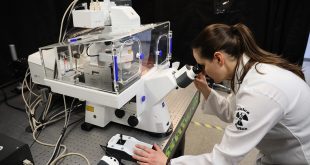By Kieran Delamont
The cannabis plant, even today, offers us a pathway into a world of mysteries and questions. Thousands of years of both formal and informal human use, much of it set against a backdrop of prohibition, has caused the plant to evolve from a naturally occurring landrace shrub in central Asia to what it has become today: an infinitely variable commodity plant with thousands upon thousands of strains, derivative products and names. With neither official sanction nor support, we have learned to breed it, smoke it, cook it and turn it into valuable textiles. We have changed cannabis, and cannabis has changed us; can you think of any other plant that has created a global community and culture like this, not to mention the emerging multi-billion dollar medical and commercial industries?
But because it has been illegal for so long, cannabis science is still catching up. In Canada, legalization has helped with that, and interested academics can now find research support from large cannabis companies like Aurora or Canopy Growth. Cannabis science is alive in Canada, in many ways and in many places. It is in the labs, where biologists continue to unlock its medical potential and where pharmaceutical companies work to bring it to patients. It is in the nurseries, where breeders and geneticists try to understand how we can improve its yield and chemical properties. It is in the universities, where public health and social science researchers measure its uses in the fight against vexing social issues like mental illness, addiction and crime. And it is, of course, in the hands of the licensed producers, who still see the potential for a thriving, profitable pot economy.
On October 17, 2019 — one year to the day after Canada legalized cannabis — McGill University in Montreal officially opened the McGill Research Centre for Cannabis (MRCC).
It wasn’t the first time a university had signalled an interest in cannabis, but it was probably the most substantive: a research initiative that spanned six faculties (medicine, agricultural and environmental sciences, law, education, science and management) and the McGill University Health Centre hospital research institute. It was a tacit admission that, as the country barrelled headfirst into legalization, scholars had some catching up to do. “There is so much information, on all fronts, that we lack,” the Centre’s director Carolyn Baglole told an alumni magazine at the time. “We want to let the data and the science unfold, learning what that story is telling us.”
Today, the research work that goes on at the MRCC is centred around three main areas: agriculture and plant science, biomedical, and socioeconomics and the law. While the pandemic slowed much of its early work, the Centre has since regained some momentum and it has started to focus on CBD, the non-psychoactive cannabinoid that has shown the most medical potential. In October 2020, it announced the creation of the CBD Research Partnership Fund a partnership with the Association québécoise de l’industrie du cannabis (AQIC) which wants to support a single promising research project in CBD. (As of writing, no recipient of this funding has been announced).
“There is still much we don’t know about cannabis,” writes Baglole. “From the plant itself, to the full secondary metabolite profile, the spectrum of potential medical applications.”
Meanwhile, across the country at the University of British Columbia, a different research project is underway to map cannabis resistance genes and, eventually, develop cannabis cultivars with a genetic resistance to powdery mildew, a common problem for cannabis growers.
“Our main goal is to develop a genomics breeding platform,” says Loren Rieseberg, a botanist with a reputation for his research into sunflowers. Traditionally, if a cannabis breeder wanted to breed for a specific trait, it would mean growing plants to maturity and crossing them. With other crops, he explains, “you could grow 10,000 corn plants and phenotype them, measure them for everything you want to measure, and simply select the top five per cent.” To do that with cannabis would require an immense amount of space, time and labour. What a genomics breeding platform would mean for cannabis breeders, however, is that “you only have to grow things up to a seedling stage, genotype them, choose the ones you want and discard the rest. It just saves space and time, and it also makes your breeding a lot more accurate, because you know exactly what you’re doing.”
While researchers like Rieseberg probe the chemical properties, others are focused on ways to harness those chemicals and use them to help people. At the Michael G. DeGroote Centre for Medicinal Cannabis Research at McMaster University in Hamilton, Ont., research is focusing on cannabis’ potential to treat patients suffering from chronic pain, as well as those living with addictions and mental health challenges.
One ongoing study out of McMaster’s cannabis research department that has attracted interest is Michael Van Ameringen’s research into its role in treating anxiety disorders research being directed out of the MacAnxiety Centre, a specialized psychiatric research centre. “The purpose of this study is to compare the effects of two different cannabidiol (CBD) formulations (CBD or CBD+THC) versus placebo (containing no medication), in adults with an anxiety disorder,” said a spokesperson for the study. (An interview on this study, citing research).
McMaster’s DeGroote Centre is also home to a number of studies related to non-cancer chronic pain, which has become the most common reason for seeking medicinal cannabis in many jurisdictions. Ongoing research projects include studies involving the use of cannabis to treat pain following a knee replacement and following orthopaedic surgery, as well as the creation of DATACANN, a database that is collecting real-world data from patients prescribed cannabis for non-cancer chronic pain, to “inform efforts to standardize cannabis-related medical education, monitor trends in clinical outcomes, and determine how to effectively predict the benefits and harms of cannabis use within a prescribed treatment regimen.”
However, not all research is unlocking new information about cannabis — sometimes it is about unlearning what we thought we knew.
At Dalhousie University, Sean Myles, an associate professor in the Faculty of Agriculture, has recently published research casting doubt on one of cannabis’ longest-held conventions: the classification of strains as either sativa, indica or a hybrid. Conventionally, growers (and, recently, retailers) have tightly held to a vernacular understanding that the plant’s psychoactive effects are broadly dictated by their sativa/indica lineage; a sativa produces a more creative, energetic high, while an indica produces a more mellow high. But when you scratch the genetic surface, Myles says, it’s not so simple.
“It’s frequently the case that something that’s labeled as a sativa is more closely related to something that’s labeled indica than it is to other sativas,” he says. “There’s a weak signal in the data, but by no means would anyone say that these labels that are applied to samples represent any meaningful identity, chemically or genetically, of the plants.”
Instead, it’s about the terpenes — essential oils contained within the trichomes of the dried flower — that are likely most determinative of the plant’s character.
A large wealth of informal knowledge had built up under prohibition, and not all of it has ever been tested rigorously. Some of the findings, like the broad substantiation of CBD’s medical properties, have borne out what medicinal cannabis advocates had been saying all along. Others, like Myles’ findings about cultivar labelling, have forced certain reconsiderations.
But what is unique about cannabis research at this moment, and what cannot be ignored, is that it is happening within the context of a society that is eager to understand cannabis. Myles’ research, to use one example, comes in the context of a terpene revolution of its own. Growers, consumers and retailers have, in the last few years, picked up on the idea that terpenes, along with cannabinoids, play a huge role in the plant’s psychoactive effects. Some within the industry are running with it as a marketing device. It is not uncommon to see cannabis brands highlighting their terpenes (usually in the form of a total percentage by weight, or as a list of major terpenes in the flower) and downplaying the sativa/indica classification. As they do that, new cannabis paradigms emerge. Sativa/indica, for instance, is increasingly understood as an anachronism.
“It’s sort of unclear,” Myles says, “the degree to which those classifications were valid in the first place.”
It would be impossible to capture all the ongoing research into cannabis chemical and medicinal properties in one article. There are now college programs designed to train the next generation of master breeders: research at the University of Lethbridge into cannabis’ effects on COVID-19, or research at the University of Victoria on the effects of cannabis on pregnancy. The list goes on, and as more universities acquire cannabis research licenses, that research world will continue to grow. “The cannabis research community has really opened up,” says Rieseberg. While it is still not the easiest research to get cleared, as Health Canada strictly regulates the industry, legalization has opened many academics up to it. “I think as it becomes legalized, and more researchers become used to having a very open environment, we’ll learn a lot more about what’s happening … There’s a lot to learn about cannabis.”
 BioLab Business Magazine Together, we reach farther into the Canadian Science community
BioLab Business Magazine Together, we reach farther into the Canadian Science community





